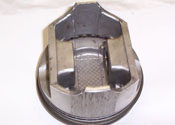The Use of Surface Conditioning Discs

The AERA Technical Committee offers the following information concerning the use of "Surface Conditioning Disks". When cleaning engine gasket sealing surfaces, and/or cleaning parts from an engine which are to be reused, DO NOT use surface conditioning disks (typically constructed of woven fiber or molded bristles) which contain abrasives, such as a high amount of Aluminum Oxide. Those disks are NOT recommended for cleaning internal engine components!
The use of such surface conditioning discs dislodges Aluminum Oxide (from the disk) and metal particles, which can lead to premature engine bearing failure. The presence of Aluminum Oxide in engine oil has been shown to cause premature engine bearing failure. In some cases, this failure occurs in as little as 1,000 miles (2,200 km) or less after the repair has been made.
Surface conditioning discs may grind the component material and imbed it into the disc. This can result when more aggressive grinding of the gasket surface takes place.
Note: Do not use abrasive pad/bristle devices to clean the gasket surfaces of engine components. Abrasive pads should not be used for the following reasons:
Abrasive pads will produce fine grit that the oil filter will not be able to remove from the oil. THIS GRIT IS ABRASIVE AND HAS BEEN KNOWN TO CAUSE INTERNAL ENGINE DAMAGE. Abrasive pads can easily remove enough material to round cylinder head surfaces. This has been known to affect the gasket's ability to seal, especially in the narrow seal areas between the combustion chambers and coolant jackets.
Abrasive pads can also remove enough metal to affect cylinder head, block, oil pan rail, and intake manifold runner flatness, which can cause coolant and oil leaks. It takes about 15 seconds to remove .203 mm (.008 in) of metal with an abrasive pad.

It is suggested a razor blade or plastic gasket scraper be used to clean gasket surfaces, please note the following:
When using a razor blade type gasket scraper, use a new razor blade for each cylinder head and corresponding block surface. Hold the blade as parallel to the gasket surface as possible. This will ensure that the razor blade does not gouge or scratch the gasket surface.
Do not gouge or scrape the combustion chamber surfaces.
Do not gouge or scratch any engine-sealing surface during the cleaning process.
The appearance of the gasket surface is not critical – the feel is. There is a possibility that there will be some indentations from the gasket left in the cylinder head after all the gasket material is removed. The new gasket will fill these small indentations when it is installed.
The AERA Technical Committee